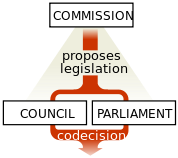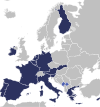Maastricht Treaty
- For the content of the treaty as of 2009, see Treaties of the European Union#Treaty on European Union
| Maastricht Treaty | |
|---|---|
| Treaty on European Union | |
| Type of treaty | Amending treaty |
| Signed Location |
7 February 1992 Maastricht, Netherlands |
| Effective | 1 November 1993 |
| Signatories | 1992 EC members |
| Languages | |
| European Union |
 This article is part of the series: |
|
Policies and issues
|
|
Foreign relations
|
The Treaty of Maastricht (formally, the Treaty on European Union,[1] (TEU)[2]) was signed on 7 February 1992 by the members of the European Community in Maastricht, the Netherlands.[3] On 9–10 December 1991, the same city hosted the European Council which drafted the treaty.[4] Upon its entry into force on 1 November 1993 during the Delors Commission,[5] it created the European Union and led to the creation of the single European currency, the euro. The Maastricht Treaty has been amended to a degree by later treaties. For details on the content of the treaty as amended by Amsterdam, Nice and Lisbon, see the treaties of the European Union article.

Contents |
Content
The treaty led to the creation of the euro currency, and created what is commonly referred to as the pillar structure of the European Union. This conception of the Union divides it into the European Community (EC) pillar, the Common Foreign and Security Policy (CFSP) pillar, and the Justice and Home Affairs (JHA) pillar. The latter two pillars are intergovernmental policy areas, where the power of member-states is at its greatest extent, whilst under the European Community pillar the Union's supra-national institutions — the Commission, the European Parliament and the Court of Justice — have the most power. All three pillars were the extensions of existing policy structures. The European Community pillar was the continuation of the European Economic Community with the "Economic" being dropped from the name to represent the wider policy base given by the Maastricht Treaty. Coordination in foreign policy had taken place since the beginning of the 1970s under the name of European Political Cooperation (EPC), which had been written into the treaties by the Single European Act but not as a part of the EEC. While the Justice and Home Affairs pillar extended cooperation in law enforcement, criminal justice, asylum, and immigration and judicial cooperation in civil matters, some of these areas had already been subject to intergovernmental cooperation under the Schengen Implementation Convention of 1990.
The creation of the pillar system was the result of the desire by many member states to extend the European Economic Community to the areas of foreign policy, military, criminal justice, judicial cooperation, and the misgiving of other member states, notably the United Kingdom, over adding areas which they considered to be too sensitive to be managed by the supra-national mechanisms of the European Economic Community. The compromise was that instead of renaming the European Economic Community as the European Union, the treaty would establish a legally separate European Union comprising the renamed European Economic Community, and the inter-governmental policy areas of foreign policy, military, criminal justice, judicial cooperation. The structure greatly limited the powers of the European Commission, the European Parliament and the European Court of Justice to influence the new intergovernmental policy areas, which were to be contained with the second and third pillars: foreign policy and military matters (the CFSP pillar) and criminal justice and cooperation in civil matters (the JHA pillar).
The Maastricht criteria
The Maastricht criteria (also known as the convergence criteria) are the criteria for European Union member states to enter the third stage of European Economic and Monetary Union (EMU) and adopt the euro as their currency. The 4 main criteria are based on Article 121(1) of the European Community Treaty.
1. Inflation rates: No more than 1.5 percentage points higher than the average of the three best performing (lowest inflation) member states of the EU.
- Annual government deficit:
- The ratio of the annual government deficit to gross domestic product (GDP) must not exceed 3% at the end of the preceding fiscal year. If not, it is at least required to reach a level close to 3%. Only exceptional and temporary excesses would be granted for exceptional cases.
- Government debt:
- The ratio of gross government debt to GDP must not exceed 60% at the end of the preceding fiscal year. Even if the target cannot be achieved due to the specific conditions, the ratio must have sufficiently diminished and must be approaching the reference value at a satisfactory pace.
3. Exchange rate: Applicant countries should have joined the exchange-rate mechanism (ERM II) under the European Monetary System (EMS) for two consecutive years and should not have devalued its currency during the period.
4. Long-term interest rates: The nominal long-term interest rate must not be more than 2 percentage points higher than in the three lowest inflation member states.
The purpose of setting the criteria is to maintain the price stability within the Eurozone even with the inclusion of new member states.
Ratification
The process of ratifying the treaty was fraught with difficulties in three states. Denmark first rejected the treaty on 2 June 1992 by fewer than 50,000 votes in a referendum. In September 1992, a referendum in France only narrowly supported the ratification of the treaty, with 51.05% in favour. Uncertainty over the Danish and French referenda was one of the causes of the turmoil on the currency markets in September 1992, which led to the UK pound's expulsion from the Exchange Rate Mechanism. The treaty was eventually ratified by Denmark on 18 May 1993 with the addition of the Edinburgh Agreement which lists four Danish exceptions.
In the United Kingdom, an opt-out from the treaty's social provisions was opposed in Parliament by the opposition Labour and Liberal Democrat MPs and the treaty itself by the Maastricht Rebels within the governing Conservative Party. The number of rebels exceeded the Conservative majority in the House of Commons, and thus the government of John Major came close to losing the confidence of the House.[6]
| Signed In force Document |
1948 1948 Brussels Treaty |
1951 1952 Paris Treaty |
1954 1955 Modified Brussels Treaty |
1957 1958 Rome Treaties |
1965 1967 Merger Treaty |
1975 N/A European Council conclusion |
1986 1987 Single European Act |
1992 1993 Maastricht Treaty |
1997 1999 Amsterdam Treaty |
2001 2003 Nice Treaty |
2007 2009 Lisbon Treaty |
||||||||||
| Three pillars of the European Union: | |||||||||||||||||||||
| European Communities: | |||||||||||||||||||||
| European Atomic Energy Community (EURATOM) | |||||||||||||||||||||
| European Coal and Steel Community (ECSC) | Treaty expired in 2002 | European Union (EU) | |||||||||||||||||||
| European Economic Community (EEC) | European Community (EC) | ||||||||||||||||||||
| TREVI | Justice and Home Affairs (JHA) | ||||||||||||||||||||
| Police and Judicial Co-operation in Criminal Matters (PJCC) | |||||||||||||||||||||
| European Political Cooperation (EPC) | Common Foreign and Security Policy (CFSP) | ||||||||||||||||||||
| Unconsolidated bodies | Western European Union (WEU) | ||||||||||||||||||||
| Treaty terminated in 2010 | |||||||||||||||||||||
See also
- Treaty of Rome (1957)
- Treaty of Amsterdam (1997)
- Treaty of Nice (2001)
- Treaty of Lisbon (2007)
References
- ↑ The Treaty on European Union
- ↑ http://books.google.com/books?id=LlGxNfddAqQC&pg=PA32&dq=%22Treaty+on+the+European+Union%22&cd=4#v=onepage&q=%22Treaty%20on%20the%20European%20Union%22&f=false
- ↑ "1992". The EU at a glance - The History of the European Union. Europa. http://europa.eu/abc/history/1990-1999/1992/index_en.htm. Retrieved 9 April 2010.
- ↑ "1991". The EU at a glance - The History of the European Union. Europa. http://europa.eu/abc/history/1990-1999/1991/index_en.htm. Retrieved 9 April 2010.
- ↑ "1993". The EU at a glance - The History of the European Union. Europa. http://europa.eu/abc/history/1990-1999/1993/index_en.htm. Retrieved 9 April 2010.
- ↑ Major Driven to Confidence Factor - Independent Newspaper Article http://www.independent.co.uk/news/uk/politics/the-maastricht-debate-major-driven-to-confidence-factor-commons-exchanges-treaty-issue-cannot-fester-any-longer-1486498.html
External links
- The Treaty on European Union - Original version
- The Treaty on European Union - Current consolidated versions of the Treaty on European Union and the Treaty on the Functioning of the European Union (in PDF)
- The History of the European Union - The Treaty of Maastricht
- Maastricht Treaty European Navigator
- Proposed 1962 treaty establishing a "European Union"
|
||||||||||||||||||||||||||
|
|||||||||||||||||||||||||||||||||||||||||
|
||||||||||||||||||||||








